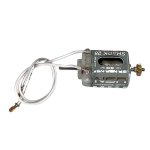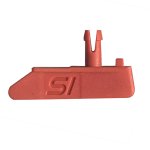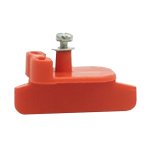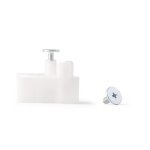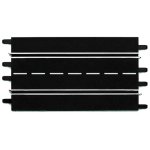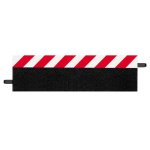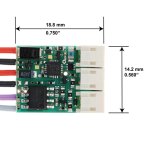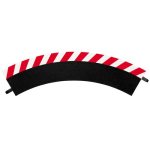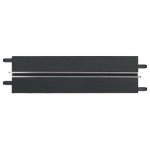Thank you for choosing LEB Hobbies as the place to purchase your slot car race set. We want every newcomer to the hobby to have a fun, successful first experience with slot cars, especially children, who may be slot car racing for the first time. If you have no previous firsthand experience with slot cars you may be confused as to exactly what slot cars and race sets are, what to expect from them, and what it takes to use them successfully.
Slot cars are different from toy cars that roll or are motorized without a track. These require no control of the car by the user. Unlike these toys, slot cars require some driving skills that to a large extent come down to instinct and getting a feel for the car and the track.
A slot car is a miniature scaled automobile that is powered by a small electric motor. The cars are raced on a track that has a groove for each vehicle lane, and the slot car has a small pin or blade that extends from the bottom and into the groove. The contacts brushes pick up the electricity from the track rails to the motor and power the car. The guide pin keeps the car in the track. The vehicle is controlled by a hand-held speed controller that filters in the voltage amount.
What are the main parts of a slot car?
· Body/Shell – The top of the slot car is molded and scaled to a real vehicle. The shape actually does not influence the car’s performance, as it would for a real car. Instead, the mass and distribution of the weight affects the car’s performance.
· Interior – The interior often features a real driver and imitates the interior of the real, life-size vehicle. The driver and interior are typically modeled just below window height to allow more room for the motor. It is usually clipped or glued to the body shell.
· Chassis – The bottom part of the car is called the chassis, which is often one piece but can be made with a separate motor pod section. This piece attaches all of the other parts.
· Motor – The electric motor is what powers the slot car, placed at the front, middle, or rear of the car. It can be in-line, sideways, or at an angle. Like a real car, small gears transmit the power from the motor to the axle.
· Axle – The axle is the steel rod in which the wheels are attached to.
· Guide or Guide Flag – This is a plastic fin with the ability to pivot, which sits on the slot of the track and holds the braids.
· Braids – Copper metal contacts or copper braids provide power to the car by making contact with the rails on the track. It’s important that these are adjusted correctly for optimal car performance.
· Magnet – Front and rear magnets provide force to keep the car on the track.
· Chip – This refers to the circuit board which interprets signals on the track and operating the motor for digital cars. Some conventional cars have a chip to control the lights, but many do not have a chip at all.
The two types of controllers that are used are called analog and electronic controllers. Analog slot car controllers allow the car to accelerate by distributing the desired amount of voltage to the car. Electronic controllers, unlike analog controllers, do not use the variable resistance method for power delivery, but instead use an electronic circuit to dispense the correct amount of voltage to the car. Because electronic controllers offer improved control and the ability to command a wide array of cars, this type of controller is most recommended for a beginner.
What are slot car racetracks made out of?
Slot cars include a variety of other features and parts and differ depending on when the car was made and the maker. The majority of the slot car racetracks used for home races are made from molded plastic snap-together track sections. This allows the racer to reconfigure their track at will. The tracks used for competition are often hand-built; the guide slots for the vehicles are routed into a type of sheet material, generally either medium-density fiberboard or chipboard. Voltage supplied to the track by the power supply is typically between 12 to 18 volts and 1 or 2 amps.
What types of slot cars are best for beginners?
Cars of the 1/32 scale are most recommended for beginners, as they are very durable and are actually the most common size among hobbyists. The cars with very strong magnets are good for beginners initially, but may limit the development of driving skills. As racing skills develop further, the magnets are needed less and less and you may find you need to update your slot car as your skills progress.
Keep in mind that the slot car coming out of the slot is part of the challenge of slot car racing. You cannot drive a slot car full speed around the entire track or it will fly off. You must slow down for the corners and can accelerate for the straights. As this can be frustrating while learning, be patient and you will see that your driving skills will improve quickly. For beginners, you can negotiate the track at one steady speed until you get the hang of it. Sometimes slow and steady wins the race. Just by staying on the track, you may win the race even if others drive faster. If racing 1/43 scale Carrera GO!!! and there is a loop in your set, you will need to go faster in that section so the car can get enough speed to make it through. Remember to let off after the loop as there probably is corner coming up!
What types of racetracks are best for beginners?
Most children age 6 or over have the eye/hand coordination and attention span to pick up the skills needed to race. However, a simple track plan allows one to learn how to drive properly and enjoy the hobby. Sometimes an oval of track is best so that beginners can learn the fundamentals of accelerating, braking and controlling speed in the corners. A more elaborate and challenging track can be then enjoyed after some skill has been developed. Unfortunately, many sets do not have a good track layout for beginners. The beauty of plastic track is that you can configure a simple oval first, practice and then expand the layout with the balance of the track to make a more challenging circuit.
Slot cars and race sets differ from most of your child’s toys in needing a certain amount of routine maintenance to keep performing properly. The track must be kept clean. The cars need to be lubricated (though very sparingly and infrequently). The pickup braids on the cars need to be cleaned, adjusted and eventually replaced. None of this is difficult and replacement parts are readily available.
As with any mass-produced product, occasional component failures can occur. This usually happens soon after you start using the race set. LEB Hobbies offers expert technical assistance that will enable you to resolve any problems and get back to racing as quickly as possible. If it is determined that you do have defective product, please contact us at 215-493-4821 or email us at customerservice@lebhobbies.com and we will instruct you how to proceed.
TROUBLESHOOTING PROBLEMS:
PROBLEM: My slot car runs sporadically or stutters.
SOLUTION: Most likely this is a conductivity problem. Your motor is not getting a constant supply of electricity.
1) The braids pick up electrical power from the rails. The greater the pressure and the better the contact area, the better your car will run. It is important that the braids are kept clean. Dirt or fluff will interfere with their connectivity. Check the braids (or contact brushes) to make sure they are not overly worn or dirty. If it is a new car, make sure the braids are frayed and curled downward so the frayed ends touch the track first. Ideally, the whole width of the braid’s end will make contact with the entire width of the rail. Replace overly worn braids with new ones or clean dirty braids with a small steel wire brush.
2) If the problem still exists, take the body off and check for loose wires. Sometimes the wire coming out of the guide works itself loose. Simply reconnect it by pulling it out the rest of the way and re-inserting it in the guide hole.
PROBLEM: My slot car keeps coming off the track.
SOLUTION: Typically this is a driving problem as the hobby does require a certain amount of eye-hand skill. People coming from HO scale slot cars or have slot cars with very strong magnets are often dismayed when they encounter a slot car that need skills to drive. There are some things, however, that can help your car stay on the track.
1) Add a stronger magnet. Magnets vary in strength, even magnets from the same manufacturer and of the same size. You can add a magnet on the bottom of the chassis by gluing it on in front of the motor, behind the contact brushes or simply stick another magnet on top of an existing one in the same location.
2) Clean your rear tires as the dirt causes them to lose traction. Simply use the adhesive side of masking tape or duct tape to clean the tires by rolling the tire across the surface.
3) Sand your tires to make sure they are true (round).
PROBLEM: The motor on my car runs, but the back wheels do not turn.
SOLUTION: Take the body off and check to see that the rear axle hasn’t come loose from its holder on the chassis or is bound up with hair or lint. If loose, simply snap the axle back into place. If hair or lint is entangled on the axle, snap the axle out of its holder and clean off the material. It is important to inspect your car after heavy crashes and new cars before running them to be sure everything is in proper alignment. Crashes or careless assembly can all cause axles or motors to come loose or pop out of their holders.
PROBLEM: My slot car won’t run.
SOLUTION: Most of the time the problem is that the motor is not getting electricity due to bad conductivity. Sometimes, but rarely, it is a bad motor. First, you need to check the braids. Fray them and curl them down so the frayed ends make good contact with the rails. If the car still won’t run, take the body off to see that both wires have good connections. A good way to test that the problem is not the motor is to lift the rear of the car off the track, making sure the guide is in the slot and the braids are making good, solid contact. Give it some power and the motor should run smoothly. If not, re-examine the braids and check again for loose wires. Usually if a motor is bad, it will not run at all or it will run and briefly and immediately give off an odor and start to smoke.
PROBLEM: My slot car slows down at certain points on my track.
SOLUTION: This is most likely a problem with your track and not your car. Make sure your track is clean and connected properly. With movement or constant set up and take down, your track connections can become loose.
PROBLEM: The track seems to only have power in one lane.
SOLUTION: The problem could be with one of four things: a bad track connection, the controller, the terminal track, or the transformer. To test the controllers, simply swap them. If the problem is not in one of the controllers or track, you will probably want to replace the terminal track. Sometimes, but very rarely, it is an issue with the transformer, in which case it will have to be replaced.


